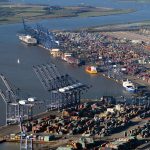Moving on to the next one on our list. In this blog, we will take you through the next technology that is, “Internet Of Things”. So what exactly is Internet Of Things (IOT) and how can it be used in shipping?
The Internet of Things (IoT) is one of the growing trends not just in shipping, but in many industries. The idea is that physical devices with sensors or the ability to capture data that will share the data with websites. The information is then used or analysed in real time or at a later time to create efficiencies. These devices contain hardware such as sensors and electronics, which gives them the ability to interact with other objects and to be monitored and controlled from afar. IoT solutions can incorporate data points from many IoT sensors but also allow users to drill down to the individual item level for asset tracking and monitoring purposes.
Although the name “Internet of Things” may be unfamiliar, you may recognize this connected ecosystem better as “smart homes” or “connected homes,” which include the various IoT devices that make your home life easier. But IoT devices are also found outside the home. They can range from a Wi-Fi pet camera on your bookshelf to a medical device implanted in your body, like a pacemaker. As long as the device is able to connect to the internet and has sensors that transmit data, it can be considered as IoT device.
Benefits of ‘Internet of Things’
In the marine industry, there are numerous benefits to embrace the Internet of Things. The major goals are to improve operational efficiency, reduce human error, minimise risk (both safety and security), and provide a higher overall quality of service.
Increased efficiency and cost reduction
The Internet of Things (IoT) offers a mechanism to send automatic, real-time shipment updates across the supply chain process, enhancing efficiency and reducing process times and costs. From loading and then unloading cargo, to transportation at the port, to warehousing, this means that being able to identify and track cargo will arm shipping companies with valuable information that allows them to make on-the-spot decisions. Everything from the location of a shipment to the projected delivery time and even the reasons for a delayed delivery will help organizations plan smarter routes and be more responsive to customers. In other words, they’ll be able to run a tighter ship! Having real-time updates is a huge bonus, but the IoT is also coming into its own when it comes to battling counterfeit goods and managing perishable inventory expiration dates.
Reducing fuel consumption and costs
The marine industry is under pressure to reduce fuel use, and the Internet of Things is proving to be a force for change in this area too. Smart metres, monitors, and sensors based on the Internet of Things are used onboard vessels to collect performance data and properly track fuel use. This not only saves money for shipowners, but also allows them to operate in a more environmentally friendly manner by reducing carbon emissions.
Data capture for better decision making
Through the use of predictive analytics, IoT solutions assist operators in making better decisions. From planning ahead for the aforementioned smarter routes to the identification of problem areas, potential delivery issues can be tackled before they become a reality. The integration of Radio Frequency Identification (RFID) and Automatic Identification and Data Capture (AIDC) technologies with the IoT are also proving to be a huge help now that they are being increasingly employed to assist with analytics.
Preempting issues with predictive maintenance
Another area where the Internet of Things is knocking it out of the park is predictive maintenance. Not only does identifying and correcting perspective and minor issues before they become major issues save money on repairs and downtime, but it also increases the crew’s safety.Shipowners and management may monitor the machinery and equipment onboard a vessel using the Internet of Things, and real-time monitoring comes into its own by allowing problems or maintenance concerns to be addressed promptly.
When the Internet of Things is utilized, vessels are better maintained and safer, downtime is reduced, logistics, cargo planning and handling and workflows are streamlined, and costs and harmful emissions are reduced.
To be continued…






